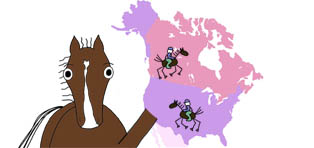An LCC instructor finishes 10,000 miles of endurance horse races
Simon Kemp
Issue date: 11/5/09 Section: Features

Two likeminded instructors at LCC have found that riding and training a rare breed of horse for endurance races is a good way to unwind after a long week of teaching, and also get outside and enjoy exercising.
Susie Morrill has been endurance riding since 1986 and recently completed 10,000 cumulative miles raced. She doesn't just race but also breeds horses, specifically a cross between Morgans and Akhal-Tekes, and trains them specifically for endurance racing. She is also an instructor in the Media Arts and Technology Department teaching photo classes, and has been for 23 years.
"One, it's a long term goal. Two, it's a really tough sport. You really have to have your act together to pull off these long distances," Morrill said. "A 50-miler you have 12 hours to complete; a 75-miler you have 18 hours to complete, and a 100-miler you have 24 hours to complete. So you're riding just extremely long times, in the dark, over mountains."
Susan Lowdermilk helps Morrill exercise the horses on weekends and other spare time, and also attends summer races with Morrill across the country. The two met at LCC through a mutual student who introduced them. They have since become not only good friends but riding partners as well. Lowdermilk is an Art and Applied Design instructor.
"It's like a marathon so there's people looking to win and people looking to finish, and I'm never looking to win because I'm a novice rider. I think even after six years there is a lot to know, but it's a great way to be outside and see the woods, and just learn something new, get exercise and communicate with this incredible animal. So it's really fun," Lowdermilk said.
Morrill started riding endurance because she had bought a Morgan horse that was too hyper to do a lot of other disciplines, and was told by a friend to try out endurance racing. The Morgan was good at endurance racing, but she just wasn't cut out for it. With a thick skin and high pulse, the Morgan could never compete for anything beyond pleasure.
Once Morrill became passionate about the sport and gained an understanding of the riding style, she realized that the perfect horses for the job would need to span long distances without straining themselves or take many breaks. She then decided to invest in a 20-year-old Seal Bay Akhal-Teke stallion to breed with her Morgan for the purpose of endurance racing, and has since had immense success in the sport because of her horses' abilities to span great distances without getting tired or even needing to stop very long to rest.
Meeting an Akhal-Teke is like meeting a piece of ancient history. The breed is not only one of the oldest breeds of horses on earth, but is also one of the most unusual and distinctive. The origin of the Akhal-Teke breed is the Turkmenistan Desert oases, and can be traced back over 2,500 years. They were considered heavenly horses in Chinese lore and the Russian Cossacks were often mounted on Akhal-Tekes because of their ability to handle climate extremes. They were the sole reason for many raids throughout history, and have been the prized mounts for many rulers. However, they are not to be taken on by an amateur. Akhal-Tekes are renowned for nothing more than their demand for a competent rider and their temper. Bred for survival through extreme heat and deprivation, they make the perfect endurance racing horses.
What sets endurance racing apart from other styles of horse racing is that the outcome is not dependent on how fast or hard somebody rides their horse, but on how well they know the horse and how they ride them. If one rides full sprint all the way to the veterinary check station then they will have to wait for their horse's pulse to return to normal again before finishing, whereas the rider who knows their horse's limits and maintains a steady rate just below that will hardly have to stop and wait for the pulse to drop back down before continuing.
"It's gorgeous. You're riding in snowstorms, you're riding in hundred and seven degree heat, it's everything. I mean half of it's the weather," Morrill said. "It's a nice family sport, and for horse sports, it's really down to earth people. It's just too hard to be less than gracious."
Morrill has been in races all over the United States including Arizona, California, Kansas, South Dakota as well as Alberta and Manitoba, Canada. Although she likes to stay mainly in the Northwest where she's close to home, friends and family.

No comments:
Post a Comment